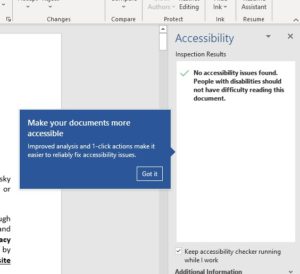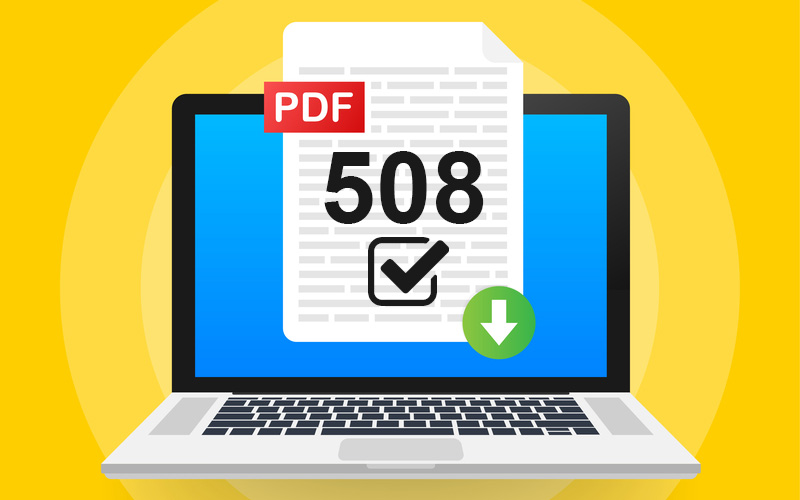When addressing accessibility concerns for your website, you may already be aware that any auxiliary documents linked to your website, such as PDFs, Word Docs, PowerPoint Presentations, Excel Spreadsheets, and more, need to meet accessibility standards for Americans with Disabilities as well, and that’s true. But which standards apply to you? Do you need to meet Section 508 standards as well as ADA? What’s the difference? And how do you know whether or not your documents are compliant?
A 508 compliant PDF is a PDF which has been structured during its creation or edited to adhere to Section 508 standards, such that it can be read or processed by people with disabilities using assistive technology. Section 508 was made part of the Rehabilitation Act of 1973 in 1998. Its purpose is to require federal agencies to make their EIT (Electronic and Information Technology) accessible.
PDF documents are everywhere and comprise a remarkable portion of all digital files. Bank statements, paperless bills, digital invoices, job postings, product brochures, application forms – almost all of these are PDF documents. So why is accessibility such a concern? Those with visual disabilities don’t “read” PDFs the same way that sighted people do. While someone with normal vision can see the contents of a PDF document, a blind or visually impaired person needs to use assistive technology to “see” the information. This includes the use of screen readers, text-to-speech-outputters, braille printers, and more.
I’m not a federal agency. Does Section 508 apply to me?
 Section 508 applies to all federal agencies and vendors, contractors, and partners of those agencies operating in the United States or abroad. If your company does business with a federal agency as a private contractor, or if you’re in the financial, health care, legal, or similar industry, this means you!
Section 508 applies to all federal agencies and vendors, contractors, and partners of those agencies operating in the United States or abroad. If your company does business with a federal agency as a private contractor, or if you’re in the financial, health care, legal, or similar industry, this means you!
Section 508 is related to a number of other laws prohibiting discrimination against individuals with disabilities, including the ADA (Americans with Disabilities Act). Many of the guidelines, therefore, overlap between the two. The difference is that the ADA doesn’t have official guidelines on what makes a PDF compliant – the key is that your document provides effective communication and accessibility to those with disabilities. In other words, if your document is fully 508 compliant, it’s also ADA compliant, but not necessarily vice-versa.
How do I tell if my PDFs are 508 compliant?
Unfortunately, it’s difficult to tell just by looking, unless you’re testing using assistive technology. You’ll need to open your PDF in your editing software (such as Adobe Acrobat) and look at the document’s properties.
Some common accessibility issues for PDFs include:
- Missing or incomplete Metadata. Your document must include title, author, subject, and keywords to be fully compliant.
- Missing tags. If a PDF doesn’t have tags, it’s not in compliance with accessibility standards. PDF tags are the key to accessing a PDF’s content with assistive technologies. Tags are assigned to each page element in the document, and stores some information about it.
- Bad tag structure. If your document is improperly tagged, it’s still. Not accessible. One example of this is neglecting to specify the reading order of your tags.
- Images missing alt text. Without alt text, a screen reader will announce that there is a graphic on the page, but it won’t know why or how it’s important. Providing alt text provides some information.
- No bookmarks. In documents longer than 9 pages, bookmarks aid in navigation. Generally speaking, these should match your headings.
- Image-only PDFs. If the PDF is a scanned document, each page is treated like one big picture. Running OCR (Optical Character Recognition) converts scanned text to searchable/taggable/readable text, which makes the document accessible.
- Incorrect or missing table headers. For data tables to be read correctly by assistive technology, the headers need to be defined, and their role (column or row) assigned correctly. Tables can be particularly tricky – most compliancy validator tools do not fix them automatically, and large tables can take 1-2 hours to make compliant by hand!
Failure to adhere to the above would cause your document to fail both ADA and Section 508 compliancy standards, but 508 compliancy has a few more checks in its “best practices” guidelines, including enhanced document properties, image treatment, and more. You can find formal checklist documents at the U.S. Department of Health and Human Services.
How can I check the accessibility of my documents?
 If you have Adobe Acrobat Pro or DC, you can use the CommonLook PDF Validator. This is a free plugin for those programs which tests your PDF document for various accessibility standards including Section 508, WCAG 2.0 AA, and others.
If you have Adobe Acrobat Pro or DC, you can use the CommonLook PDF Validator. This is a free plugin for those programs which tests your PDF document for various accessibility standards including Section 508, WCAG 2.0 AA, and others.
An option for Acrobat is using the “Quick Check” option in the accessibility panel. This checks for tags. Full accessibility checks are currently only available inside Acrobat Pro. If you have Acrobat Pro, you can perform a full accessibility check by doing the following:
- Click “Accessibility Check” in the Accessibility Panel.
- Check “Create Accessibility Report in the document.
- Scroll down the Full Check dialog box and under “Checking Options”, select any items you want to check.
- Click “Start Checking.” This generates a report and creates comments in the document. Any errors are reported in the comment notes.
Section508.gov also has a checklist for creating and testing for 508 Accessibility with PDFs. The fact is, no existing software automatically makes your documents fully accessible – all must be manually reviewed, even if you use tools.
How do I know if my Word document is 508 compliant?
 The U.S. Department of Health and Human Services has an excellent tutorial that can help you understand how to create your Word documents with an eye towards 508 compliance.
The U.S. Department of Health and Human Services has an excellent tutorial that can help you understand how to create your Word documents with an eye towards 508 compliance.
To manually check accessibility in Word, click the “Review” tab in the main menu. Then click the “Check Accessibility” to open the “Accessibility” task pane. Alternatively, to open it if you are running an older version of Word, click the “File” tab in the main menu to open the Backstage view. Then click the “Info” command at the left side of the Backstage view. Click the “Check for Issues” drop-down button in the “Inspect Document” area to the right. Then choose the “Check Accessibility” command from the drop-down to open the “Accessibility” task pane.
If you’re running Word 2019 or Word for Office 365, these let you run the accessibility checker as a background tool so you can constantly and automatically check your document as you create it. When enabled, a new “Accessibility” status appears within the Status Bar, so you can see if you have any accessibility issues that arise as you create the document. You can click this status at any time to easily open the Accessibility pane.
Is there anything I can test by myself?
 There are things you can definitely test on your own in terms of making your PDFs Section 508 compliant. The University of Washington has an excellent checklist that you can start with. Additionally, WEBAIM has a very detailed tutorial for checking accessibility in Acrobat.
There are things you can definitely test on your own in terms of making your PDFs Section 508 compliant. The University of Washington has an excellent checklist that you can start with. Additionally, WEBAIM has a very detailed tutorial for checking accessibility in Acrobat.
Or, you can start by asking yourself the following questions:
- Does my document contain text? If the document is a large image, it will need to be converted to readable text. You can do this in Acrobat by going to View->Tools->”Recognize Text.”
- Is my document tagged? PDF “tags” determine the order and structure of PDFs for screen reader users, and the Tags pane in Acrobat allows you to view, reorder, modify, create, or delete these tags. You can get to the Tags pane by going to View->Show/Hide->Navigation Panes->Tags.
- Is my document assembled in reading order? To check this, use the Reading Order Tool (or TURO in older versions of Acrobat.) To use this, go to the Accessibility Tools and select Reading Order. The appearance of your PDF will change – the content will become encased in numbered grey boxes. If this doesn’t happen, your PDF document is likely untagged, and you need to revisit step 2 and add your tags before proceeding to this step.
- Do my images have alt text? To add or edit alternative text, right click on the image and select “Edit Alternate Text.” Alt text is a short description of the image which makes it accessible to vision-impaired users who rely on assistive technology.
- Does my document have tables? If yes, use the Table Inspector. This can be found within the Reading Order tool described in step 3. The WEBAIM tutorial below will help walk you through repairing inaccessible tables.
If you’re using Acrobat Pro, try the “Make Accessible” Action Wizard. Action Wizards automate common multi-step processes in Acrobat, including several common steps in creating an accessible PDF. It is a helpful way to ensure you don’t miss any steps while making your document accessible. To run the wizard, use the Tools tab to add Action Wizard (it should be visible by default in Acrobat XI), then open Action Wizard and choose “Make Accessible.” The wizard will then run you through several steps necessary for guaranteeing PDF compliance.
Your PDFs Likely Won’t Be Accessible…
It’s very likely that your PDFs won’t be accessible on their first pass through any inspection software. At this point, you’ll need to either make your file compliant manually, or you’ll need professional help; especially if you have a large number of PDF files. White Whale Web Designs specializes in all Section 508 and ADA website compliance concerns, and can help you bring your PDF and Word documents up to accessibility standards.

